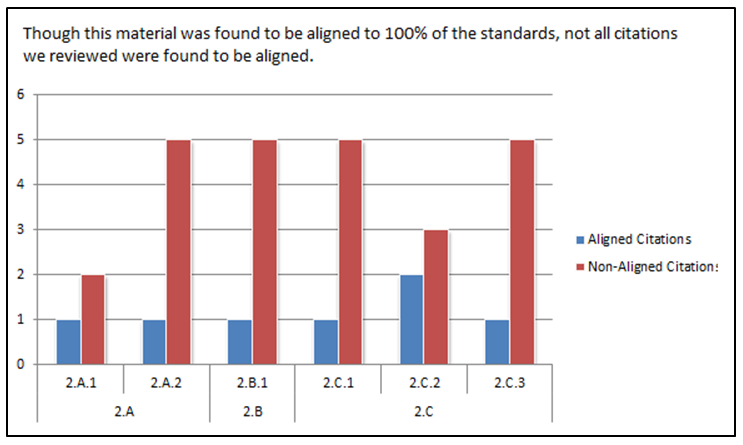Learning List has reviewed the standards alignment of thousands materials. After reviewing a material’s alignment, we calculate the percentage of standards to which the material is aligned.
When you log into LearningList.com, you will see the alignment percentage for each product. Be aware that an alignment percentage of 100%, does NOT mean that every citation (e.g., page, lesson, video) listed in the publisher’s correlation was found to be aligned to the relevant standard. Rather, 100% alignment means that Learning List’s subject matter experts found at least one aligned citation for each standard. In other words, 100% aligned means that every standard was fully addressed at least once in the material.* 
Learning List’s subject matter experts review multiple citations for alignment to each standard.** As this table reflects, typically one or two of the citations reviewed are found to be aligned to the standard; several others are found not to be aligned. In order to be sure that students will learn all the knowledge and skills the standards require, teachers must know which citations are aligned to the standards and which are not.
Our detailed alignment reports show (1) which citations (from the publisher’s correlation) were reviewed for alignment to each standard, (2) which of those were found to be aligned to the standard, and (3) which were found to not to be aligned. Moreover, a reviewer’s comment accompanies each non-aligned citation to explain precisely which part of the standard the citation failed to address.
These alignment reports make it easier for teachers to assign citations that have been verified to be aligned to each standard. If teachers want to assign a non-aligned citation, the reviewer’s comment explains how they should adjust their instruction to make up for the material’s deficit(s).
Preparing your students for success requires you to be a critical consumer of the instructional materials you are using. The alignment percentage of a material alone does not tell the whole story. Even when a material has an alignment percentage of 100%, there are likely citations in the publisher’s correlation that are not aligned to the standards. The alignment reports on LearningList.com provide the critical information you need to use your instructional materials effectively in your instruction.
*Learning List recognizes that a single “aligned” citation may not be instructionally sufficient to help students “master” the standard. Some level of repetition is typically required for students to understand, internalize, and master content and skills. That is the reason Learning List reviews multiple citations for alignment to each standard.
**If the publisher’s correlation lists fewer than three citations as aligned to a standard, Learning List’s subject matter experts review all of the citations listed. If the publisher’s correlation cites more than three citations for a standard, Learning List subject matter experts review up to eight citations looking for at least three citations that are aligned to the standard. If teachers want to use a citation that Learning List has not been reviewed, they should check the alignment of the citation themselves. However, Learning List’s alignment report serves as a guide as to how likely it is that any additional citation would be aligned to that standard.